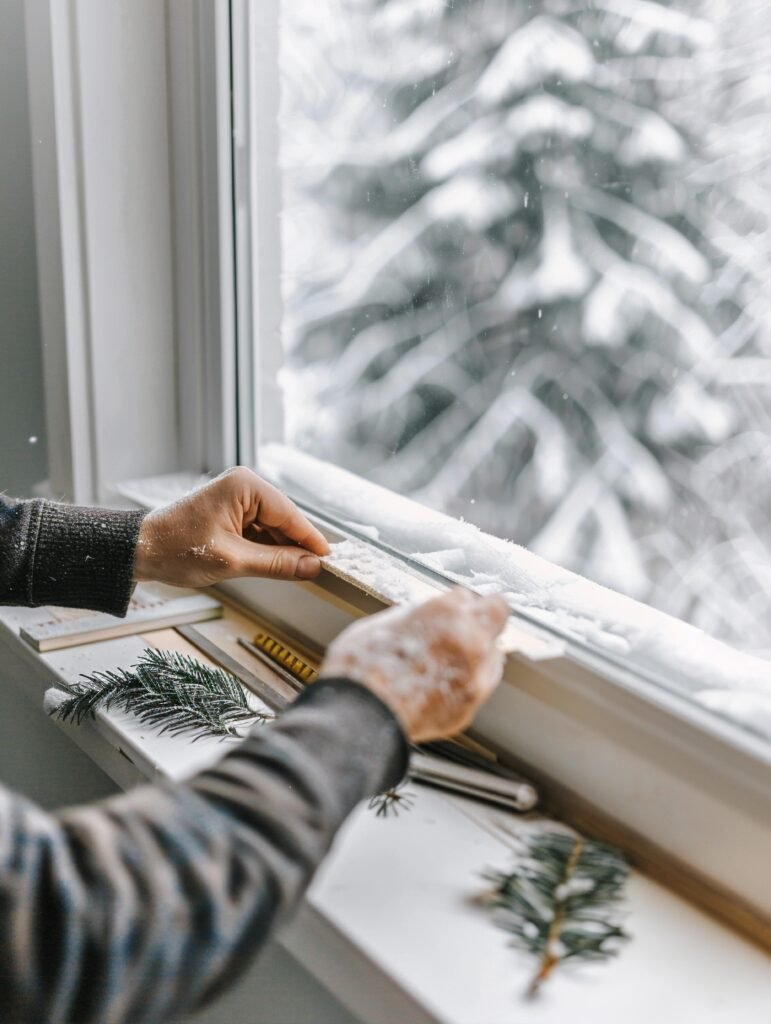How To Winterize Windows From The Inside?
When the cold of winter begins to sneak in through your windows, you’re facing more than just the chilly air you’re also dealing with rising heating bills. Preparing your windows for winter from the inside is a clever and cost-effective method to make your home warmer and more energy-efficient. By blocking drafts and adding better insulation, you can keep the cold and warmth out. This makes your home more cozy and helps you control your energy expenses.
Preparing your windows for winter from the inside involves easy steps that anyone can do, no matter how good you are with DIY projects. Whether using insulating film, adding weatherstripping, or even homemade solutions like draft snakes, each method helps keep the heat in. With just a few basic tools and materials, you can protect your windows from the cold weather, ensuring your home stays warm and shielded from the outside.
Now, let’s go through the steps and techniques to winterize your windows from the inside effectively. This will help you cover every part of the process, ensuring no cold air enters your cozy home.
What is Window Winterization?
Window winterization is about preparing your home’s windows for the cold and rough winter weather. The main purpose is to improve how well your windows keep heat in, which helps reduce the heat that escapes your home. This keeps your rooms warmer without needing to use the heating system too much and also helps you save on energy bills.
Window winterization means making your windows better at keeping out the cold by adding insulation and sealing any air leaks. You can do this in several ways, like using insulating films, weatherstripping, putting up heavier curtains or insulated window coverings, and sealing gaps with caulk that can be temporary or permanent. Properly winterized windows help keep your home comfortable by holding in the warmth and blocking the cold air from getting in.
Assessing Your Windows
Before you start winterizing, it’s important to check the current state of your windows. This helps you find and fix any specific issues with each window, making your efforts more effective. Begin by looking closely at each window for any damage or wear that might affect its ability to insulate properly.
Look for clear problems like cracks in the glass, gaps between the window frame and the wall, or old and worn-out seals and weatherstripping. Check around the edges of each window for drafts and notice if any windows feel especially cold, which could mean they’re not insulating well. Also, make sure each window opens and closes smoothly. If a window sticks or jams, it could be misaligned, letting cold air in.
Paying attention to these details will help you choose the best way to winterize each window. If a window has a lot of damage, you might need to fix it or replace it before you start winterizing. Doing a careful check like this ensures that your approach fits each window’s needs and boosts the effectiveness of your winterizing work.
Materials Needed to Winterize Windows

Winterizing your windows doesn’t need a lot of tools or materials, but having the right ones can make the job easier and more effective. Here are the basic materials you’ll need to get your windows ready for the cold:
- Weatherstripping: This is used to seal gaps around windows that open and close. It comes in different materials like foam, rubber, or felt. Pick the type that best fits your window needs, considering the size of the gap and how long the material lasts.
- Window Insulation Film: This is a plastic film you put over the window glass to trap air and reduce heat loss. You attach it with double-sided tape and then use a hair dryer to heat it, which shrinks the film and smooths out any wrinkles.
- Caulk and Caulking Gun: Caulk is used to fill any cracks or gaps in the window frame and between the frame and the wall. A caulking gun makes it easier to apply the caulk evenly.
- Draft Snakes: You can make these yourself or buy them. They are filled with materials like sand or rice and placed on the window sill to stop drafts.
- Insulated Curtains or Drapes: These are made of heavy fabrics or special thermal materials that keep the heat in and the cold out. They are especially useful when drawn during the evening or on very cold days.
- Foam Insulation Boards: In very cold areas or for windows that you don’t use in the winter, you can cut foam insulation boards to fit the window space. This creates a strong barrier against the cold.
Getting these materials ready before you start will make your project go smoothly, letting you move quickly from one window to another. Each of these materials helps protect your home from the cold, making sure you stay warm inside during the winter.
Step-by-Step Guide to Winterizing Windows
Winterizing your windows from the inside is an easy process that can help keep your home warm and save on energy costs. Here’s a step-by-step guide to help you block out those cold drafts:
- Clean Your Windows and Frames: First, clean the glass, frames, and sills well. Dirt, dust, and moisture can stop insulation materials from sticking properly. Use a gentle cleaner and make sure everything is dry before you move on.
- Apply Weatherstripping: Measure the edges of the window where the moving parts of the window (the sash) meet the frame. Cut pieces of weatherstripping to these measurements. Remove the backing and press the sticky side firmly in place. Check that the window can still open and close easily—this means it’s a good fit.
- Install Window Film: Stick double-sided tape all around the window frame, making sure it’s smooth and secure. Then, place the insulation film over the tape, pulling it tight to avoid wrinkles. Use a hair dryer to gently heat the film. This shrinks the film and removes any wrinkles, creating a tight seal around the window.
- Caulk Any Gaps: Look around the window for any cracks or spaces between the frame and the wall. Use a caulking gun to apply caulk smoothly into these gaps, making sure they are filled to stop air leaks. Smooth the caulk with a damp finger or a tool for a neat finish.
- Use Draft Snakes: Place draft snakes along the window sills or at the bottom of the windows to block any remaining drafts. These are especially useful for older windows that tend to leak air.
- Hang Insulated Curtains: Finally, put up heavy or insulated curtains and keep them closed during very cold times or at night. This adds another layer of insulation, helping to keep heat inside.
Following these steps will effectively keep the cold out of your windows, making your home more comfortable and lowering your heating costs during the winter. Each step adds to making your home warmer and more energy-efficient.
Maintenance and Care
To make sure your efforts to winterize your windows last, it’s important to maintain and take care of them regularly. Here’s what you can do to keep everything working well:
- Regular Inspections: Check the weatherstripping and caulking around your windows from time to time. These materials can wear out or come loose, especially if they’re used a lot or if temperatures change a lot. If you see any cracks or gaps, put on more caulk or replace the weatherstripping as needed.
- Clean the Window Film: If you’ve put window insulation film on your windows, keep it clean by lightly wiping it with a soft, damp cloth. Don’t use strong cleaners or scrub too hard, as that could damage the film.
- Operate Windows Carefully: When you open and close windows that have been winterized, do it gently to avoid pulling off the weatherstripping or ripping the insulation film. Being careful helps the materials last longer.
- Check for Moisture: Watch for any signs of moisture around the windows, which can mean the seal isn’t working right. Moisture can cause mold to grow and wood to rot, so it’s important to fix any leaks as soon as you spot them.
- Refresh Draft Snakes: If you’re using homemade draft snakes, check them once in a while and replace the filling if it gets wet or isn’t insulating well anymore. For store-bought draft snakes, make sure to follow the care instructions from the manufacturer to keep them working well.
- Reassess Each Season: At the end of winter, take some time to evaluate how well your window winterization worked. Decide if the steps you took were effective and think about what could be improved for next year.
By following these tips for maintenance and care, you can keep your window winterization effective year after year. This will help keep your home warm and your heating costs low.
In conclusion
In conclusion, preparing your windows for winter from the inside is a smart and cost-effective way to keep your home warm and energy-efficient during the cold months. By using weatherstripping, window insulation film, caulk, and other insulating materials as outlined in the step-by-step guide, you can greatly cut down on heat loss and keep out cold drafts. Keeping up with regular maintenance ensures that your efforts continue to work well, giving you lasting warmth and helping you save on energy. With these steps, you can enjoy a warmer home and handle the winter cold easily, all while keeping your heating bills under control.
FAQs
What does it mean to winterize windows?
Winterizing windows involves applying materials like weatherstripping, insulation film, and caulk to seal drafts and improve a window’s ability to keep heat inside during colder months.
Can I winterize windows from the inside by myself?
Absolutely! Winterizing windows from the inside is a straightforward DIY project. You’ll need basic supplies like weatherstripping, window film, and caulk, all of which can be applied with minimal tools.
What are the most effective materials for winterizing windows?
The most effective materials include weatherstripping for sealing gaps, thermal insulation film to reduce heat loss through the glass, and caulk to seal cracks around window frames.
How often should I replace the insulation materials on my windows?
It’s a good idea to check your window insulation annually. Replace materials like weatherstripping and caulk if they become worn out or if you notice drafts coming through the windows again.
Do insulated curtains help in winterizing windows?
Yes, insulated curtains or drapes add an extra layer of insulation, helping to keep your room warm by trapping heat and blocking cold air from entering through the windows.







